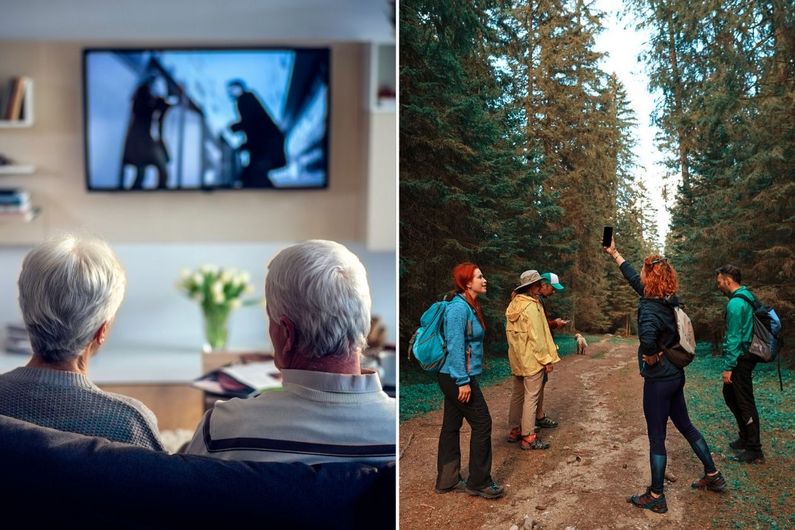Cultural and outdoor activities: a growing gap within the Canadian population
- UdeMNouvelles
04/17/2023
- Martin LaSalle
Sociology professor Stéphane Moulin believes a generation gap as well as an urban-rural gap are emerging in Canada around how people do things like watch movies and exercise.
How much are Canadians participating in cultural and outdoor activities? What do they have in common and what sets them apart?
This is what Stéphane Moulin, a sociology professor at Université de Montréal, sought to find out by examining responses of 7,344 people who took part in the General Social Survey conducted by Statistics Canada in 2016.
His analysis had two objectives: to identify personal profiles that include both cultural and outdoor activities and to identify the determinants of these profiles by exploring the socio-demographic, economic, cultural, health and identity factors of the people taking part in the survey.
To meet these objectives, Moulin contrasted two theories of cultural sociology, namely the cultural distinction framework and the omnivorism thesis.
The cultural distinction framework was developed by the French sociologist Pierre Bourdieu. It focuses on the opposition between so-called legitimate (or intellectual) culture and popular activities deemed less legitimate (or non-intellectual). Omnivorism refers to the idea that people from the higher social classes tend not so much to pursue distinctive practices as to pursue an eclectic blend of cultural practices, which stands in contrast to the working classes whose cultural activities are more exclusive or univorous (as opposed to omnivorous).
Five groups of participants
The StatsCan data made it possible to group people into five categories of participants in cultural and outdoor activities:
- 14 per cent of Canadians are television univores, i.e. they mainly listen to traditional TV or radio. They are over 65 years old, live in both urban and rural areas, and are both less educated and have lower incomes.
- 28 per cent are "indoor connectors" who listen to music on electronic devices and read the news and watch films over the Internet. They are generally young and urban.
- 11 per cent are indoor classicists who read newspapers, magazines and books in paper format, listen to TV, radio and music in the conventional way, and go on regular cultural outings. They are older, more educated and more likely to be high earners.
- 16 per cent are outdoor univores: they live mostly in the countryside and have less education, they enjoy fishing, snowmobiling, motorized water sports and hiking in the wilderness, as well as listening to conventional radio and TV and reading paper newspapers.
- 31 per cent are omnivores – most of them urban and educated – who pursue a wide range of activities from going to the theatre to hiking in the mountains, visiting historical sites or museums, and listening to TV, music or news online or in the traditional way.
Three main conclusions
Moulin drew three main conclusions from the data.
“First," he said, "the results confirm the theory of omnivorism while showing that cultural capital – educational attainment, as represented by a diploma – is more important than economic capital in explaining who participates in particular activities. Actually, there are univores on the one hand who have few qualifications and whose activities essentially revolve around TV or radio, while on the other hand there are omnivores most of whom have a diploma and on whom there are social pressures to do and see everything in order to be in the know.”
"Second, people living in rural areas – that is, communities with less than 1000 inhabitants – tend to participate slightly more than urban dwellers in outdoor activities, particularly hunting, fishing and outdoor motorized activities, but they participate less in cultural activities.
“Third, the shift to digitization and the increase in outdoor activities seem to have widened the gap between older and younger generations."
Another finding that surprised Moulin was that ecological awareness is not unique to any group in particular.
“There is a new body of literature that talks about the ecological habitus," he said. "I expected to find a category of people who practised exclusively environmentally friendly outdoor activities. But this is not the case. Urban omnivores are ultra-connected and participate in all activities, including outdoor motorized activities, fishing and mountain biking.”
Promoting a greater diversity
Moulin said the results of his research could “promote specific policies aimed at making young people more aware of other activities” than ones requiring them to stay constantly connected.
“If young people continue to prefer connected activities to cultural outings in person, there is a risk, as they grow older, that the cultural industry will face more difficulties in the future," Moulin said.
"It could prove politically important to make these young people aware of the importance of cultural outings in our social and democratic life. We also need to develop tools to increase cultural offerings in the regions, in order to prevent the gap from widening between the regions and big cities.”
The most and least popular activities
Here are the most and least popular cultural and outdoor activities among all respondents to Statistics Canada’s 2016 General Social Survey.
The five most popular activities in the 12 months before the survey
- Watching a movie online or on TV (89%)
- Listening to conventional radio (87%)
- Watching traditional television (85%)
- Listening to music online (79%)
- Reading the news online (79%)
The five least popular activities in the 12 months before the survey
- Picking wild fruit or mushrooms (19%)
- Going cross-country skiing or snowshoeing (15%)
- Attending a symphony or classical music concert (15%)
- Mountain biking (15%)
- Going hunting (7%)











